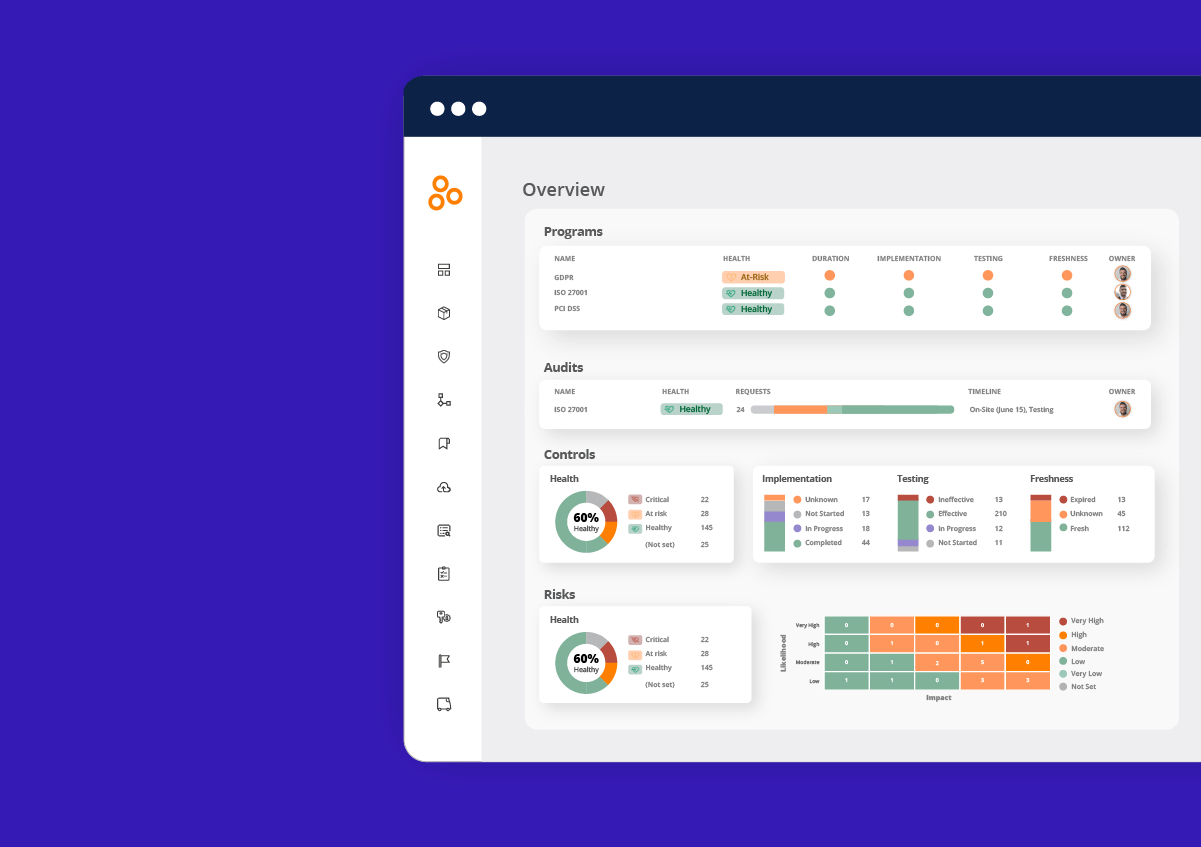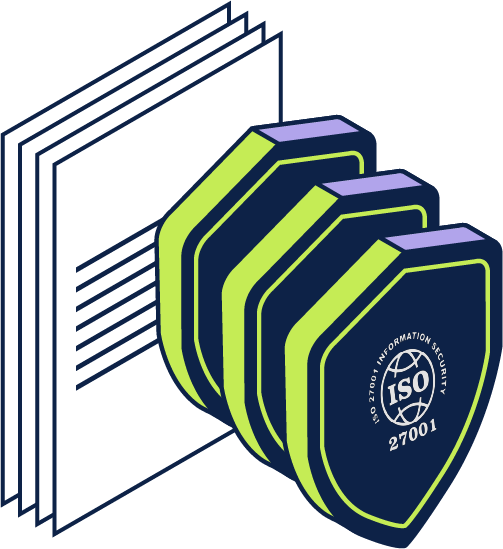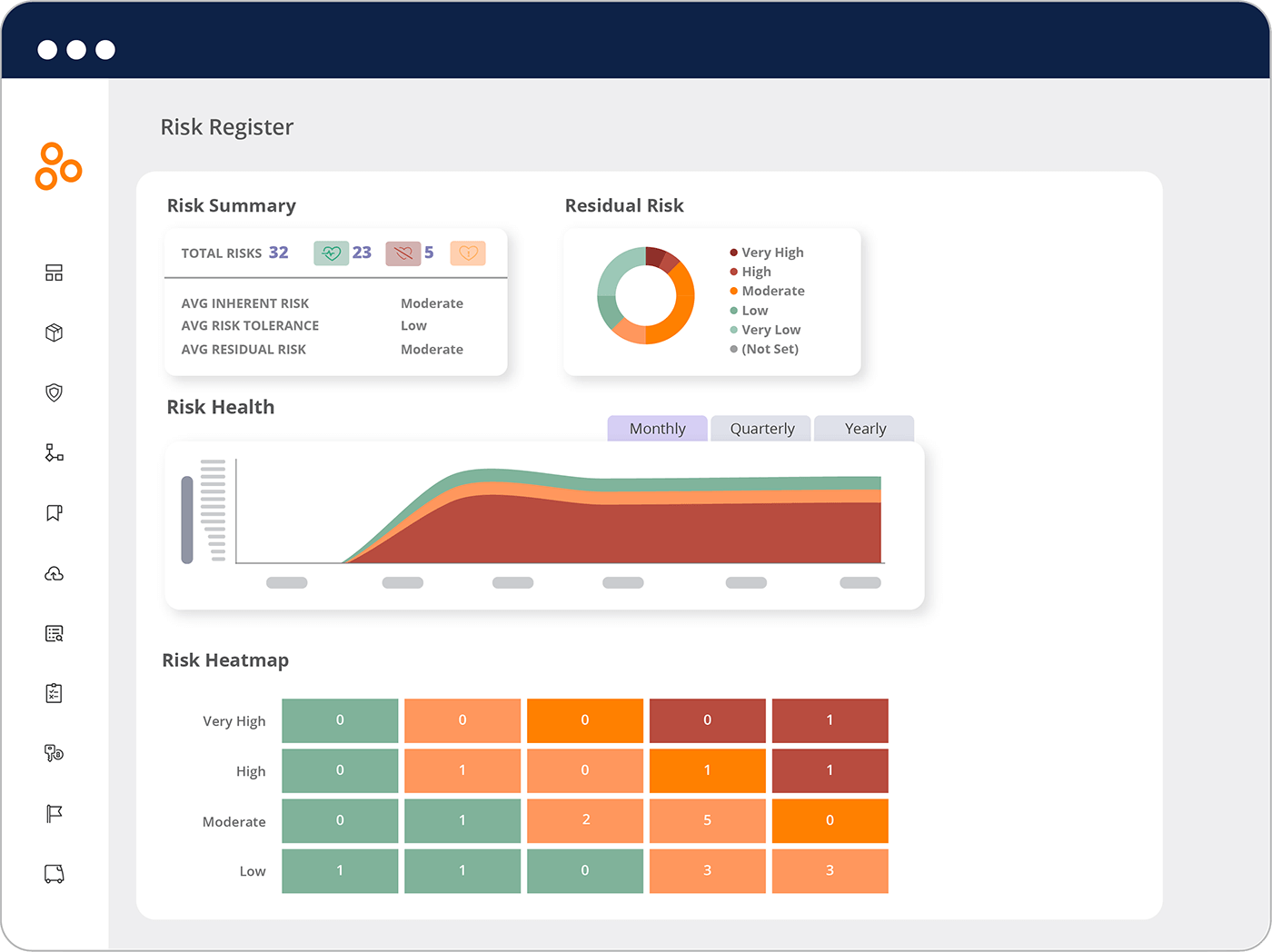GRC Platforms: 8 Features to Look For
When it comes to adding a Governance, Risk, and Compliance (GRC) platform to your existing tech stack, it helps to start with a clear definition. A GRC platform is software that centralizes governance, risk, and compliance activities so you can replace spreadsheets, reduce manual audits, and manage obligations in one place. As global enterprises expand across products, legal entities, and geographies, managing compliance efficiently has become a mission-critical challenge. Redundant controls, fragmented compliance processes, and manual audits slow down market expansion, increase operational costs, and drain team resources.
That’s why the right GRC platform shouldn’t be about checking boxes. It should be about driving growth, efficiency, and building trust at scale with the goal to transform GRC from a cost center to a strategic value prop.
What is a GRC platform?
A GRC platform is a centralized software solution that helps organizations manage governance, risk, and compliance activities in one place. It connects risks, controls, policies, and audits so teams can automate workflows, monitor compliance in real time, and give leadership a single, up-to-date view of their risk and compliance posture.
- Centralizes risks, controls, policies, and evidence
- Automates workflows for testing, approvals, and audits
- Provides dashboards for real-time risk and compliance reporting
- Integrates with tools like Jira, cloud providers, and identity platforms
Before you start evaluating GRC platforms

Before comparing tools, get clear on why you need a GRC platform: it’s the backbone that standardizes how your organization manages risk, tracks controls, and proves compliance to stakeholders. Before you start the evaluation process, there are a few things to consider. Here is a helpful framework of questions that will help you take a step back and evaluate your organization’s needs:
- What problems do you need to solve right now and in the next 12 months?
- What are your key stakeholder expectations?
- What internal resources do you have for implementation and maintenance?
- What’s your budget, and what is the ROI of implementing a GRC platform?
Investing time in discovery will make your evaluation process smoother and ensure that your GRC solution fits your organization’s unique GRC maturity level. Once that groundwork is done, focus on these eight must-have features.
Top 8 most important GRC platform features

1. Workflow automation

Manual testing and evidence collection are no longer feasible. To manage GRC at scale, organizations need smart automation that minimizes manual work, eliminates redundancies, and reduces errors. It’s important to note that automations should make your team’s life easier and free up time for them to spend in more strategic areas. Automated workflows can help your team:
- Assign and track tasks automatically
- Route evidence collection to the right stakeholders
- Eliminate repetitive control testing
- Maintain audit trails
Managing a GRC platform (and compliance program) should be an active, ongoing process that requires strategic human contribution and oversight at every step. After all, the knowledge and expertise of employees are what make GRC what it is. Automations should fit into your existing workflows and make your life easier, not harder.
2. Continuous controls monitoring (CCM)

Modern GRC platforms come equipped with Continuous Controls Monitoring (CCM), which automatically validates control effectiveness across your environments and alerts your team to issues in real time. Instead of reacting to control failures after they happen, CCM provides continuous, data-driven assurance that your environment remains secure and compliant. This allows leadership to maintain confidence in compliance posture and respond to risks proactively.
Hyperproof customers like Appian have automated control orchestration across 100+ frameworks, reducing duplicative controls by 66% and saving 350 hours per year on audit prep.
3. Secure and scalable
Security should never be a tradeoff. The right GRC platform delivers enterprise-grade protection and helps you build trust.
A truly secure and scalable GRC solution ensures that every user, device, and integration is verified before access is granted. This means sensitive data like control evidence, risk assessments, and audit reports remain protected. Encryption, multi-factor authentication, and fine-grained access controls help safeguard your environment while keeping collaboration seamless.
Secure access to the right data is important, too. Your GRC platform will contain information about your greatest vulnerabilities, so it’s vital that stakeholders only get access to what they need to do their work. Rich collaboration tools within GRC platforms allow you to control who can access what while still enabling team efforts. Creating tasks, managing teams, and remaining secure should be easy and intuitive within the tool, so you can keep your data safe and organized.
Scalability is another essential piece of the puzzle. As your organization grows across business units, regions, and frameworks, your GRC platform should scale effortlessly. The best solutions allow you to extend security policies, frameworks, and workflows across teams and entities without additional complexity.
“The dashboard provides a clear, up-to-date view of our risk landscape, enabling us to monitor key risks and track compliance metrics seamlessly. Its real-time data ensures that leadership is always informed of the current risk status, helping them make timely and data-driven decisions.”
Cynthia Yin // Head of Cybersecurity Products GRC, Thales
4. Intuitive UI and UX

Many legacy GRC platforms come with interfaces that are clunky and difficult to manage. Others have flashy UI and UX with vulnerable databases that anyone could infiltrate. An intuitive UI/UX helps teams adopt the platform quickly, reduces training time, and improves overall compliance culture. When a GRC platform is easy to navigate, your team spends less time managing the tool and more time managing risk.
Luckily, modern, AI-powered GRC solutions deliver ease-of-use so your team can easily manage compliance without building Excel formulas or spending hours trying to navigate an unintuitive platform.
5. AI-powered GRC features
AI is reshaping GRC, challenging organizations to manage emerging risks responsibly while empowering them to achieve new levels of speed, accuracy, and assurance. Many AI product features began as basic automation and chatbot-style assistance, but AI has evolved to a more agentic approach, continuously acting and anticipating with a human-in-the-loop.

Across GRC, leaders are using AI to:
- Accelerate evidence collection and testing
- Continuously monitor risks and controls
- Predict emerging risks based on patterns
- Summarize and synthesize evidence in a few clicks
It’s important to note that not all AI is created equal. Many GRC tools offer narrow, task-based automations that are useful for speeding up individual workflows, but are limited in their ability to scale and often lack the due diligence required to be safe and secure. As more regulation to manage AI risk is implemented, organizations should look for platforms with AI features that balance innovation with accountability.
At Hyperproof, our AI features were built on the foundation of five core tenets:
- Security and privacy at the center
- Full transparency and explained results
- AI with human oversight.
- Protect customers, protect trust
- Risk management and data governance
Hyperproof AI is the only adaptive, unified GRC system that embeds AI across the entire GRC lifecycle with transparency and human oversight built in. Rather than bolting AI onto existing features, Hyperproof has built intelligence into the fabric of the platform, enabling continuous assurance across compliance, risk, and audit functions.
As AI becomes more embedded in GRC, responsible AI governance is now essential. Hyperproof AI is designed with human-in-the-loop control, explainability, and transparency to ensure every automated action enhances accuracy, accountability, and trust.
With trust becoming a true market differentiator, AI is going beyond automating and turning it into a strategic advantage.
How do you prove the value of a GRC tool to the board?

6. Integrated risk and compliance workflows

Disconnected spreadsheets can’t keep up with modern GRC programs. Managing compliance in spreadsheets makes reporting slow, manual, and error-prone. Data doesn’t update automatically, so teams waste hours pulling information together and still can’t be confident they are sharing the latest numbers.
A modern GRC platform changes that. With Hyperproof, you get real-time dashboards that show exactly where you stand. See which controls are in good shape and which need attention. Track key risks, monitor changes over time, and view control performance all in one place. With Hyperproof AI, you can summarize results, identify red flags, and share insights with executives in minutes. Dashboards give every stakeholder a single source of truth they can trust. Data updates automatically, visualizations are consistent, and you can see your risk posture at a glance. Robust GRC dashboards and reporting should enable you to instantly present what matters most and communicate your organization’s GRC health.
“We’ve gone from manually pulling evidence of controls to having those controls continuously documented. Hyperproof has saved hours of our time.”
Mark Lee Director of Information Security //
Appian
7. Seamless integrations
If your GRC platform doesn’t connect to the tools your team already uses, you’re stuck doing the work twice. Jumping between systems to pull reports or upload evidence wastes time and increases the chance of errors.
The right GRC platform seamlessly integrates with your existing tech stack, so data flows automatically and compliance work happens where your team already operates. With all your compliance data, evidence, and controls in one place, you gain time back to focus on higher-impact work.
Strong integrations set the foundation for a successful GRC program. They connect all the parts of your compliance operations so teams can collaborate, automate, and move faster.
Hyperproof has 70+ Hypersyncs that seamlessly connect with the tools you love, like Jira, AWS, Okta, Cloudflare, and more. Hypersyncs help you automate evidence collection, eliminate busywork, maintain accuracy, and scale your GRC program without adding complexities.
“Hyperproof’s Hypersyncs make my life so much easier by streamlining evidence collection.”
Kathleen McNaughton Security & Compliance Engineer //
Artemis Health
8. A robust framework library
One of the biggest differentiators in modern GRC platforms is the breadth and depth of framework support. Having a robust framework library empowers teams to quickly adapt to new regulations, reduce audit fatigue, and maintain continuous compliance as standards evolve.
The right solution should give you access to a comprehensive library of industry frameworks so you can manage multiple compliance standards without duplicating effort.
Hyperproof provides the largest framework library on the market, allowing organizations to easily map controls across 120+ frameworks. This flexibility allows teams to scale compliance efforts across jurisdictions and industries without starting from scratch.
Looking for more framework resources?

Find what matters to your organization
Ready to see Hyperproof in action?

Choosing the right GRC platform is hard, but knowing what’s most important for your organization makes the decision clear. You need a platform with all the features listed above that enable your team to maintain compliance without the headache of manual processes or inflexible legacy solutions.
Hyperproof gives you everything you need to manage GRC at scale. It’s intuitive, flexible, and built to eliminate spreadsheets for good so your team can focus on strategy, not admin work. In simple terms, a GRC platform is the system of record that brings all your governance, risk, and compliance work together so everyone is working from the same, always-current source of truth.
See Hyperproof in Action
Related Resources
Ready to see
Hyperproof in action?












